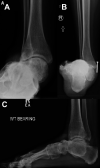Ankle Arthritis
- PMID: 35097330
- PMCID: PMC8500397
- DOI: 10.1177/2473011419852931
Ankle Arthritis
Abstract
Ankle arthritis is a major source of morbidity impacting a younger working age population than hip and knee arthritis. Unlike the hip and knee, more than 70% of ankle arthritis cases are post-traumatic, with the remainder being inflammatory or primary arthritis. Nonoperative treatment begins with lifestyle and shoe-wear modifications and progresses to bracing, physical therapy, anti-inflammatory medications, and intra-articular injections. Ankle arthrodesis and total ankle arthroplasty are the 2 main surgical options for end-stage ankle arthritis, with debridement, realignment osteotomy, and distraction arthroplasty being appropriate for limited indications.
Level of evidence: Level V, expert opinion.
Keywords: ankle; ankle arthritis; ankle arthrodesis; arthritis; total ankle replacement.
© The Author(s) 2019.
Conflict of interest statement
Declaration of Conflicting Interests: The author(s) declared the following potential conflicts of interest with respect to the research, authorship, and/or publication of this article: Vu Le, MD, FRCSC, reports personal fees from Purdue Pharma (Canada), outside the submitted work. Andrea Veljkovic, MD, MPH, FRCSC, reports grants from Acumed, from AIC, from Therapia, personal fees from Arthrex, grants from Zimmer, outside the submitted work. Kevin Wing, MD, FRCSC, reports grants from Acumed, grants and personal fees from Wright medical, grants from Ferring, grants from Zimmer, grants from Synthes, grants from Bioventus, outside the submitted work. Murray Penner, MD, FRCSC, reports grants and personal fees from Wright medical, grants from Zimmer, grants from Synthes, grants and personal fees from Springer, grants from Arthrex, other from Cdn. Orthop. Foot & Ankle society, other from Intl. Federation of Foot & Ankle societies, outside the submitted work. Alastair Younger, MB, ChB, MSc, ChM, FRCSC, reports grants and personal fees from Acumed, grants and personal fees from Wright medical, grants and personal fees from Ferring, grants and personal fees from Zimmer, grants from Synthes, grants and personal fees from Bioventus, outside the submitted work. ICMJE forms for all authors are available online.
Figures












References
-
- Agel J, Coetzee JC, Sangeorzan BJ, Roberts MM, Hansen ST. Functional limitations of patients with end-stage ankle arthrosis. Foot Ankle Int. 2005;26(7):537–539. - PubMed
-
- Al-Ashhab ME. Primary ankle arthrodesis for severely comminuted tibial pilon fractures. Orthopedics. 2017;40(2):e378–e381. - PubMed
-
- Albert E. Zur resection des kniegelenkes [For the resection of the knee joint]. Wien Med Press. 1879;20:705–708.
-
- Amendola A, Petrik J, Webster-Bogaert S. Ankle arthroscopy: outcome in 79 consecutive patients. Arthroscopy. 1996;12(5):565–573. - PubMed
Publication types
LinkOut - more resources
Full Text Sources
Research Materials
